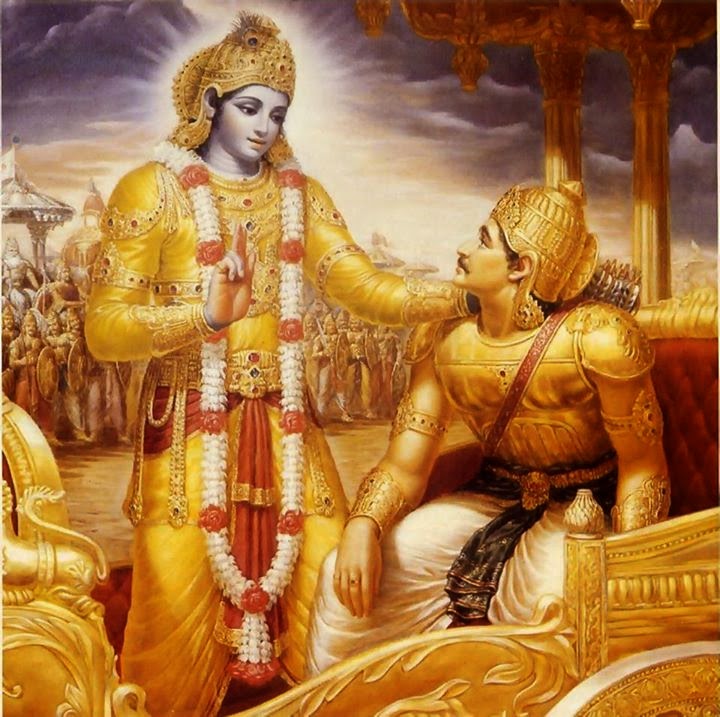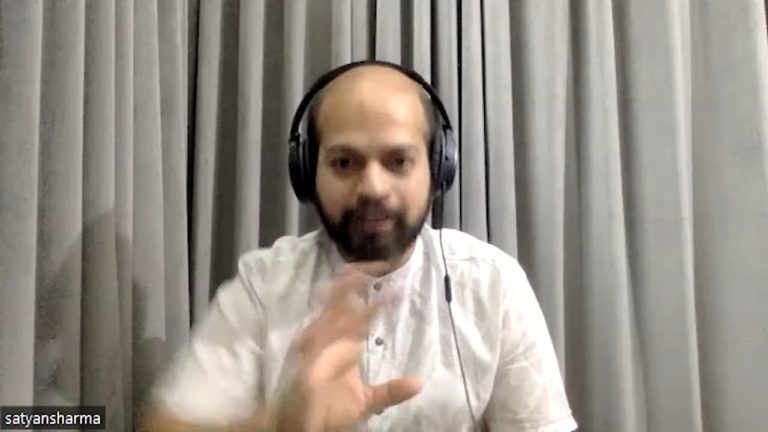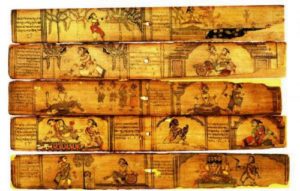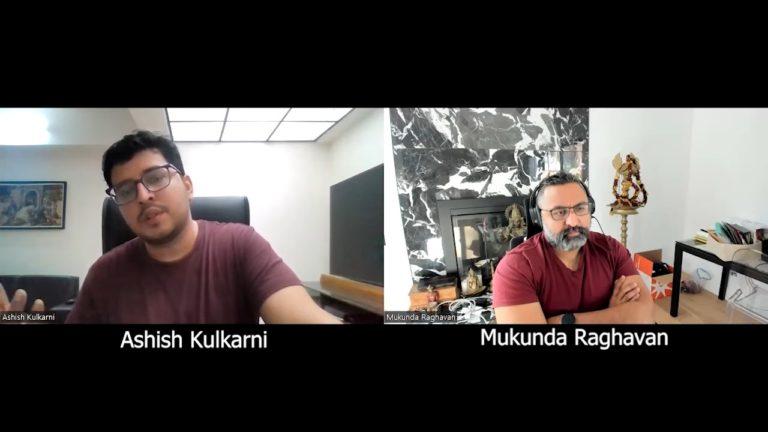Today is Krishna Janmashtami, technically the Birth of Krishna on the 8th day after the new moon. I want to do a short blog on Krishna, I will spend much more time on Krishna in later blogs and podcasts but today I want to discuss something short on Krishna. In India and across the world, most Hindus celebrate the birth and the stories of baby and adolescent Krishna. Adolescent Krishna has dozens of exploits and adventures which have captured the minds and hearts of billions of people throughout time and the world, most of these stories or Leela which means play of Krishna come from a variety of textual sources and traditions but primarily from the Bhagavata Purana and the Harivamsa, the latter is a khila or appendix of the Mahabharata which means the lineage of Hari or Krishna.
Krishna was born in a prison, raised in a village by farmers and cowherds, he grew up with common people and that experience plays a role in his large vision of dharma and nature of ruling. He was adopted by a cowherd Nanda and his wife Yashoda, they kept him hidden as he was being hunted by a tyrant Kamsa. It is during this time in his life when many of the leelas which he is so loved for occurred. Krishna during this period is mischievous, joyful and vibrant youth, the stories of his youth are full of fun and adventure, stories of innocence with a hint of a cosmic significance. When Krishna comes of age he discovers his true parentage and then kills the tyrant Kamsa who had imprisoned his parents. He only meets his birth parents Vasudeva and Devaki when he is a teenager.
Krishna of the Mahabharata is the vision of Krishna I want to focus a bit more on. In the Mahabharata, Krishna is first introduced into the story sort of in media res, or in middle of the action. He is an adult and a prince of a republic or confederacy of different ancient tribes. He belongs to a lineage known as Vrshni, descendants of an ancient king named Yadu. So accordingly in the Mahabharata, he is called Varshneya or descendant of Vrshni line and a Yadava, a descendant of Yadu. While most of the nations and people in Mahabharata were kingdoms it is the people of Krishna who were republics, they didn’t have a king but a leader of the republic, who was answerable to people of the various tribes. Krishna’s formative teenage and young adult life was in midst of the politics and interactions of these various tribes. It is here he learns statecraft, diplomacy, and politics.
When we are introduced to Krishna in the Mahabharata, he is a bit of an enigma to most people, he is well known but not well respected by most people only a handful of people hold him in high esteem, in fact, the highest esteem. We view Krishna as God or the avatara/incarnation of Vishnu but to most people in the Mahabharata he is simply a cunning and manipulative leader of one of the republics. He befriends his cousins the protagonists of the Mahabharata, the five Pandava brothers: Yudhishtra, Bheema, Arjuna, Nakula, and Sahadeva. It is their relationship and story that forms the core of the Mahabharata but we will delve into that another time. Krishna’s meeting and relationship with the Pandavas changes the face of the world that is described in the Mahabharata.
In the course of the Mahabharata, we end up on a cusp of a massive war, a war considered in the text as a world war, were nearly all kingdoms and people of the known world were participants of. A war that left millions dead and an entire generation of men destroyed. At the dawn of the war, Arjuna the greatest warrior of his time falls into a deep despondency at the thought of killing all these people. It is before the beginning of this war, situated alone between the two massive armies that dialogue between Arjuna and Krishna takes place, the Bhagavad Gita. Throughout the text, there are statements and instances where Krishna’s divinity is presented but it is in the Bhagavad Gita that a full fledge theophany occurs, Krishna reveals himself to Arjuna, as God of gods and sum bonum of all things. While this is extremely important this is not the part that I want to dwell on today.
Most people focus on the devotional and metaphysical elements of the Gita but to me the more important element, whether or not you accept the divinity of Krishna, that is vital for all people is Krishna’s conception of Dharma. Krishna reveals a revolutionary and dynamic vision of Dharma, the path of righteousness and morality. He shakes the foundations of an older vision of a fixed and immutable Dharma focused purely on honor and egoism to one that is for the benefit of all beings. Two of these revolutionary ideas are lokasamgraha and yogakshema.
Lokasamgraha which literally means holding the world together (Loka means world and Samgraha is holding together). Krishna says in Gita Chapter 3 Verse 20:
“Karmanaiva Hi Samsiddhim Aashitaa Janakaadayah
Loka Samgraham Evaapi Sampashyan Kartum Arhasi
Yad Yad Aacharti Shreshthas Tat Tad Evetaro Janah
Sa Yat Pramaanam Kurute Lokas Tad Anuvartate”
“Through the performance of necessary duties did King Janaka and other attain perfection
You should perform your work for the good of the world, setting an example for all.
Whatever actions a great person does, such behavior is followed by people
Whatever standards that person sets, all the world follows”
Krishna is saying what Gandhi later paraphrased “Be the change you want to see in the world”. Krishna goes even deeper, saying it is our obligation and duty to act for the benefit of others. He doesn’t say act to protect your family, tribe, religion, community but he says the world. What we do impacts people around us, either directly or indirectly as an example for others to follow. Krishna is explicit that both intent and action matter, why you do something is important. If you do something for yourself yet it helps others that is limited but if your actions are self-less focused on the benefit of others, that action can lead you to perfection like it did for people like Janaka.
Yogakshema is two words Yoga and Kshema, Yoga means to acquire what is not possessed and Kshema is the uncorrupted unbroken enjoyment or maintenance of what has been acquired. In regards to this, Krishna says in Chapter 2 Verse 45:
“Traigunya Vishaya Veda Nistraigunyo Bhava Arjuna
Nir Dvando Nitya Satvastho Nir YogaKshema Atmavan”
The physical world of the three gunas (Sattva-Peace, Rajas-Activity, Tamas-Inertia/Ignorance) is the realm of the Vedas, Oh Arjuna. Free yourself from these gunas and from the duality of things, focus on Truth and do not care to acquire things and to protect what is acquired, be fixed on the Self
Krishna is telling us to clear our minds of things that cloud it, our attachment to things, feelings, desires and so on. These things bind us to even more desires, things, and emotions. Act with equanimity to things, act because it is the right thing and be ever abiding in the Self or in knowledge of reality. This is the call to individuals to act in equanimity, free from the mental and physical bonds that burden us. Krishna binds these two ideas together and says:
“Saktaah Karmani Avidvaamso Yathaa Kurvanti Bhaarata
Kuryaad Vidvaams Tathaasakthas Cikirsur Loka Samgraham”
O Arjuna (Bhaarata), just as those who are ignorant of truth are attached to their activities, the wise who are unattached to the activities and its fruits should act for the benefit of the world
The ignorant or people who don’t know or want to know that they aren’t their feelings, desires, emotions, and things around them act with the intention focused on them, while those who know and wish to understand themselves and the world, these people seek to act for the benefit of the world. We are asked to act and act for the right reasons. Krishna in his next verse says the wise should focus on their own actions and intents without attacking the intelligence of those who are ignorant, everyone has their own nature which they follow but the wise should understand and free themselves of that nature.
The Bhagavad Gita spends a lot of time working through the metaphysical and spiritual elements of reality but it also spends a lot of time on focusing on the nature of human existence and how to live a good life. I love Krishna, in fact, many people that know me think I’m obsessed with Krishna. I am an agnostic, I don’t know if there is God or anything more than this physical world but I deeply believe in a multilayered reality and believe that reality is a mix of physical, psychological, mental and something deeper connected to consciousness, whether that consciousness is God or not, I don’t know. That all being said, my obsession with Krishna comes from a place of trying to understand what he did and said. His sayings in the Gita and various other parts of the Mahabharata which deal directly with the human condition have enamored me.
Krishna’s vision of morality and human existence is complex and it is extremely thought-provoking to the point where I think he is one of the greatest thinkers if not the greatest thinker of all time. He brought a drastic epic shift in thought. He brought into question why we act and then how we should act both in our actions and intents. His insight into the nature of the mind is ever relevant and necessary to understand the human condition. In a world today that is entirely focused on our egos (social media), our place in the society (money or status) or relationships to people around (over-focus on our tribal mentality), Krishna offers solutions to all of this. He first offers explanations on why and how we become bound by these things then he gives us a way out of just focusing on these things with a vision of a reality that is integrated, united and dynamic. He is called Jagat Guru or the Teacher of the World because he cuts across all distinctions we have and drives deep into our core.
While to most people Janmashtami is the celebration of the birth of Krishna the God, for me it is a celebration of Krishna the great thinker, advisor and teacher. Krishna and his sayings are there for us to grapple with and try to be better in the realm of all activity. His teachings help us to free our minds, our fears, our ego and our bonds of psychological suffering. One of the most beautiful sayings of Krishna that we should constantly meditate on is this:
“Vidya Vinaya Sampanne Brahmane Gavi Hastini
Suni Chaiva i Svapake cha Panditah SamaDarshinah”
That wise person, situated in knowledge of the self, sees with equanimity and unitary vision the Brahmana, the cow, the horse, the dog and the dog eater”
Krishna is telling us a person who is truly in wisdom looks at all beings no matter their birth, status, importance or utility with the same vision. That person doesn’t see beings differently at their core, respects, all the same, gives them all consideration because they are all united together. That same existence and consciousness is in all beings, so why do we have this ego? No being is higher or lower in the ultimate account, we are all joined and connected. This vision of reality is very much needed in this day and age and in every day and age. These differentiations are all products of our mental concepts, move beyond them, be in the moment and meditate on that unity. The life of one being is no less important than another so act without those bonds, situated in Truth and without concern for the consequences, act because it is the right thing to do.
Doing the right thing is never easy and never without consequences but one must nonetheless act and be willing to accept those consequences. If someone commits injustice one must confront it and try as hard as they can to avoid violence or harm in fixing it but there are times when harm is necessary and one should not shirk away from that. Everything comes at a cost, every person is responsible for their own part in that but acting for the good of all, freed from the bond of mind, emotions, and concepts that person is acting selflessly. This is Krishna’s message, that cuts across all time, places and situations, a message of undertaking one’s duty to the world and humanity, freeing oneself from the duality of existence and seeing the oneness of all. It is a beautiful vision of reality, with deep nuance and implications for us all. On this Janmashtami I want us to consider this message and vision of Krishna, the Lord of Yoga and Friend of All.
Yatra Yogeshvarah Krishno Yatra Partho Dhanurdharah
Tatra Sri Vijayo Bhutir Dhruva Nitir Matir Mama
Wherever there is Krishna the Lord of Yoga and Arjuna the mighty wielder of the bow
There is certainly Auspiciousness, All Forms of Wealth, Victory and Righteousness, that is my opinion









+ There are no comments
Add yours